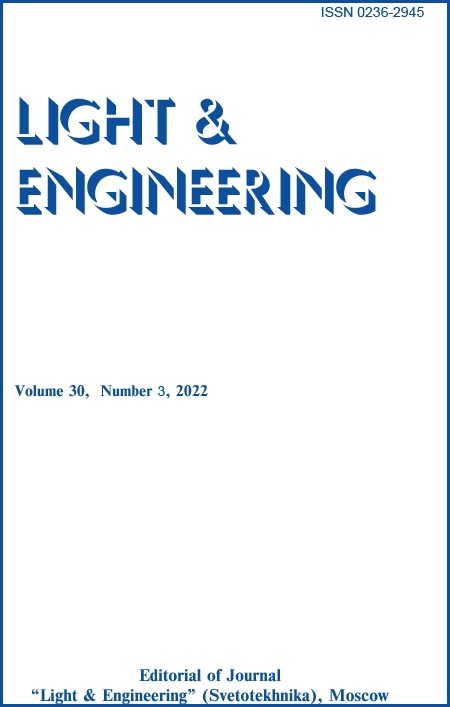Content

Light & Engineering 30 (3)
Volume 30Date of publication 06/06/2022
Pages 107–113
Abstract:
To date, finding the dominant and complementary wavelengths and excitation purity given in domestic standards and educational literature is rather descriptive and does not contain a clear calculation procedure. In general, for test engineers who in their professional activities rely on software measuring instruments, the current situation is not a problem. However, for developers of standards and measurement procedures it can be a serious obstacle. In this connection, the review of existing as well as development of new computer methods of calculation of the specified quantities is of interest. In this paper, we propose a new numerical method for calculating the dominant and complementary wavelengths, based on the following property. The distance between a considered chromaticity and a ray with beginning at the point of achromatic stimulus, which crosses the spectrum locus, takes a positive value on one side of the line, connecting achromatic stimulus and considered chromaticity, and a negative value on the other side. The peculiarity of the method is that both dominant and complementary wavelengths can be simultaneously determined for the considered chromaticity. In addition, the article deals in detail with the calculation of excitation purity.
References:
1. Heredia, F. J., Chozas, M.G. Proposal of a novel formula to calculate dominant wavelength for colour of red wines // Food Chemistry, 1992, # 2 (43), pp. 125–128. 2. Kelly, K.L. Colour designations for lights // Journal of research of the National Bureau of Standards, 1943, (31), p. 271. 3. Krivosheev, M. I., Kustarev. A.K. Colour measurements / Moscow: Energoatomizdat, 1990. 4. McCarley, J. E., Green, C. E., Horowitz, K.H. Digital System for Converting Spectrophotometric Data to CIE Coordinates, Dominant Wavelength, and Excitation Purity // J. Opt. Soc. Am. 1965, # 4 (55), pp. 355–360. 5. Prytkov, S.V. On the calculation of lines of constant correlated colour temperature[O raschyote linij postoyannoj korrelirovannoj cvetovoj temperatury // Problemy i perspektivy razvitiya otechestvennoj svetotekhniki, elektrotekhniki i energetiki: materialy XII Vserossijskoj nauchno-tekhnicheskoj konferencii s mezhdunarodnym uchastiem v ramkah III Vserossijskogo svetotekhnicheskogo foruma, pod red. O.E. Zheleznikova (otv. red.), A.A. Ashryatov (zam. otv. red.), A.M. Kokinov [i dr.]] / Saransk, Afanasiev V.S. 2015, pp. 191–196. 6. Prytkov, S. V. A new calculation table for determining the correlated colour temperature using the Robertson method [Novaya raschetnaya tablica dlya opredeleniya korrelirovannoj cvetovoj temperatury po metodu Robertsona // Problemy i perspektivy razvitiya otechestvennoj svetotekhniki, elektrotekhniki i energetiki: materialy XII Vserossijskoj nauchno-tekhnicheskoj konferencii s mezhdunarodnym uchastiem v ramkah III Vserossijskogo svetotekhnicheskogo foruma / pod red. O. E. ZHeleznikova (otv. red.), A.A. Ashryatov (zam. otv. red.), A.M. Kokinov [i dr.]. / Edited by O.E. Zheleznikova, Saransk: Afanasiev V.S., 2015, pp. 196–202. 7. Robertson, A.R. Computation of Correlated Colour Temperature and Distribution Temperature // J. Opt. Soc. Am. 1968, # 11 (58), pp. 1528–1535. 8. Schanda, J. Colorimetria: understanding the CIE system / J. Schanda, Hoboken, New Jersey: John Wiley & Sons, Inc. 2007. 9. Warschewski, D., Brungs, M.P. A Compact Computer Programme for the Specification of Dominant Wavelength and Purity // Colour Research & Application, 1980, #3 (5), pp. 173–174. 10. Yao, Q. at al. Relationship between Peak Wavelength and Dominant Wavelength of Light Sources Based on Vector-Based Dominant Wavelength Calculation Method // LEUKOS, 2013, #10, pp. 11–18. 11. Zheleznikova, O.E., Prytkov, S.V., Kokinov, A.M. Evalution of Correlated Colour Temperature Calculation Methods // Journal of Engineering and Applied Sciences, 2017, № 8 (12), pp. 2054–2057. 12. Zhou, S., Liu, S. Transient measurement of light emitting diode characteristic parameters for production lines // The Review of scientific instruments, 2009, (80), p. 095102. 13. GOST R8.749–2011. State system for ensuring the uniformity of measurements. Light emitting diodes. Methods of photometric measurements: National Standard of the Russian Federation: Official: first introduced: introduced 2013–05–01 Moscow: Standardinform, 2014. 13 p. 14. GOST R55703–2013. Electric light sources. Methods of measuring spectral and colour characteristics: Federal Agency for Technical Regulation and Metrology, Lodygin Research Institute of Light Sources, Moscow: Standardinform, 2015. 53 p. 15. GOST R8.888–2015: Reference light emitting diodes (LED) of none coherent radiation. Technical requirements / National Standard of the Russian Federation: Official edition introduced for the first time: date of introduction 2016–07–01 Russian Federation, VNIIOFI – Russian Research Institute of Optical and Physical Measurements, Moscow: Standardinform, 2016. 11 p.
Keywords
- dominant wavelength
- complementary wavelength
- excitation purity
- spectral chromaticity coordinatesй
- spectrum locus
- purple boundary
- monochromatic stimuli
- achromatic stimulus
- constant dominant wavelength line
- calculation method
Recommended articles
On the Issue of Transformation of Spatial Photometric Systems. L&E 27 (3) 2019
Evaluation of Photobiological Efficiency of Spectrum–Combined LED Phyto-Irradiators in Photo-Culture Cucumber Growing L&E, Vol.30, No.3, 2022
Constructive and Software of a Gonio-Radiometer for UV Radiation Sources L&E, Vol.31, No.5, 2023





